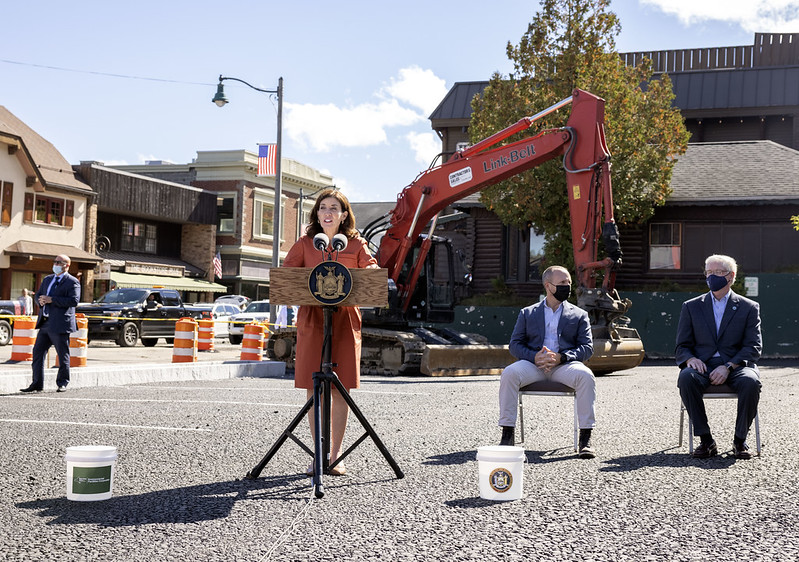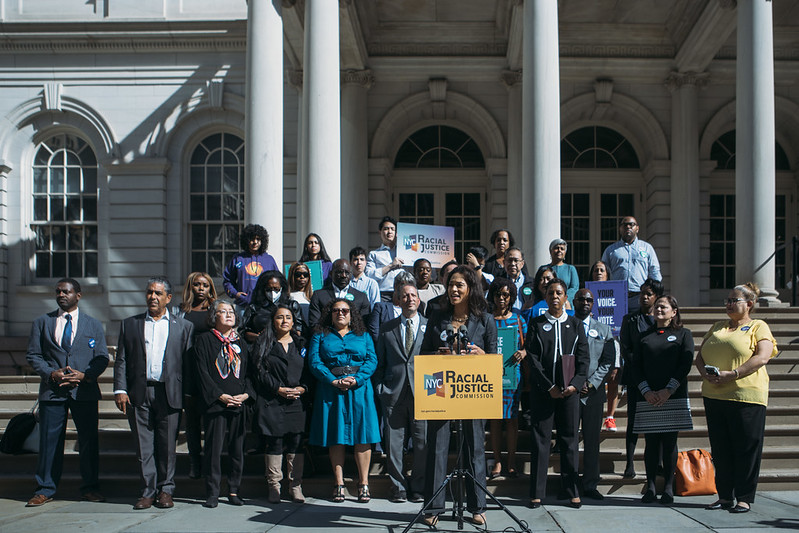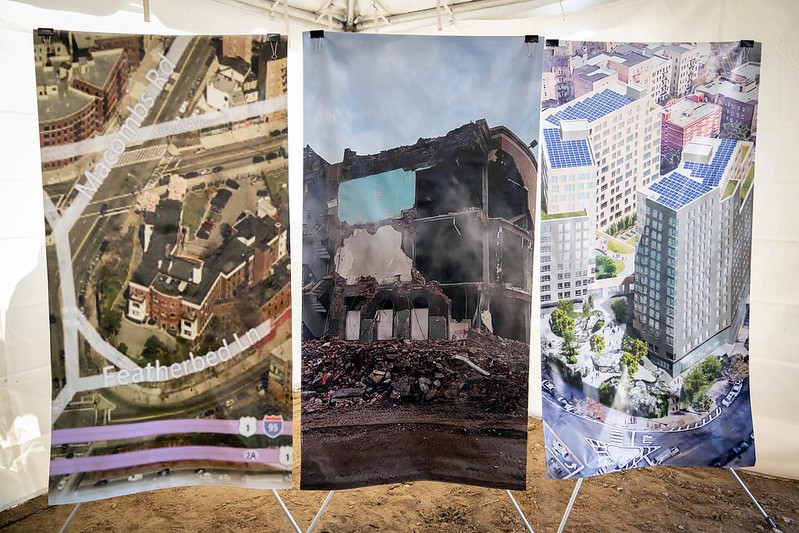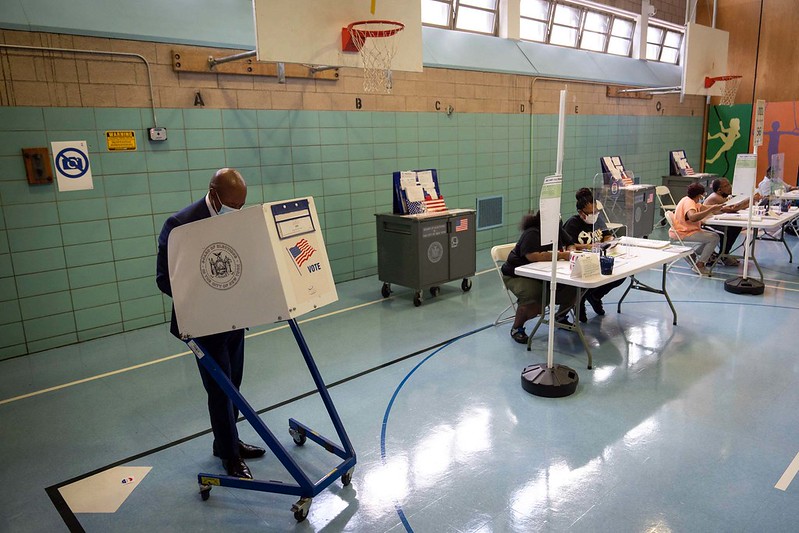
Mayor de Blasio (photo: Michael Appleton, Mayor's Office)
On Monday, The Mayor’s Office of Operations released the Mayor’s Management Report for Fiscal Year 2016, which ran from July 1 2015 to June 30 2016. For nearly 40 years, the MMR has been a report card of sorts for city agencies that the public and City Council can use to assess city performance in delivering services to New Yorkers. It now includes over 2,000 reported data points, giving indication of progress, or regress, against certain goals and past performance.
When Mayor Bill de Blasio, now in his third year in office, took power, he adjusted the MMR by asking that his commissioners include more information about how their agencies are fighting to reduce inequality in the city. The directive aligns with the focus of de Blasio’s mayoral campaign and a key animating theme of his tenure.
“The MMR embodies our commitment to transparency and accountability and it is one of the ways we use data to improve City services for all New Yorkers,” said de Blasio, in an open letter attached to the MMR. “I’ve often talked about the inequities in our society as a Tale of Two Cities,” the mayor’s letter continues. “With the MMR, you will get a detailed look at how City government is tackling these inequalities and creating a New York that is inclusive and fairer for all.”
The MMR is broken into seven categories with individual sections laid out for 44 city government agencies, and an additional category, “Collaborating to Deliver Results,” specifically for looking at cross-agency initiatives like Vision Zero, Young Men’s Initiative, Career Pathways, Housing New York, and ThriveNYC.
Otherwise, the MMR divides the 44 agencies into relative groups: Public Safety and Access to Justice, Basic Services for All New Yorkers, Health and Human Services, Building Human Potential, Infrastructure and Sustainability, Promoting Viable Communities and Neighborhoods, and Administrative Services. Key metrics are provided for each of the agency sections and the collaborative initiatives.
A press release from the Mayor’s Office announcing the release of the MMR gives a snapshot of how the city did in FY16: “In fiscal year 2016, 59% of indicators show improved or stable performance, compared to 57% in fiscal year 2015 and 56% in fiscal year 2014. For critical indicators, which are key measures of agency performance, 56% show improved or stable performance in fiscal year 2016, compared to 56% in fiscal year 2015 and 55% in fiscal year 2014.”
The MMR includes data on traffic accidents, crime stats, graduation rates, water main breaks, Citibike users, emergency response times, and much more.
Below, find Gotham Gazette-selected highlights of the MMR, with several indicators of stability or improvement for New Yorkers and several examples of regression or areas of concern. Most references to increase or decrease are in terms of fiscal year 2016 compared to fiscal year 2015.
THE POSITIVE
Reductions in Some Violent Crimes
Murder and nonnegligent manslaughter deceased by 2 percent, from 348 in FY15 to 341 in FY16. Additionally, murders related to domestic violence decreased from 61 to 53, or 13.1 percent. While these crime drops are noted in the MMR press release, it fails to paint the whole picture of violent crimes in the city (see “Rise in Major Felony Crimes”).
Fewer Bosses Denying Paid Sick Leave
After initially focusing on educating business owners about complying with new laws requiring five paid sick days be provided by all New York City employers with at least five workers, officials began enforcing the requirement more fully in fiscal 2016. Initially under the new law, the City was receiving more complaints against employers denying paid sick leave, but those have decreased as employers became more aware of the new laws and adjusted their budgets accordingly. That said, the City began fully enforcing the new law across the board after issuing early warnings and focusing exclusively on the bad apples who were not responding to the educational campaign.
Thus, 13,675 employees took in $2.1 million in restitution during FY16, compared to only 97 workers who received $54,961 in the previous fiscal year. The number of complaints against bosses denying required paid sick leave dropping from 583 in FY15 to 335 in FY16, according to the New York Daily News.
More New Yorkers Are Recycling
The Department of Sanitation improved its residential recycling diversion rate to 16.9 percent in FY16, up nearly 1 percent from FY15. The volume of refuse disposed slightly increased as well, suggesting New Yorkers were disposing of more overall waste in FY16. As Politico New York points out, this improvement still falls short of the city’s goal of 19 percent for the fiscal year. By comparison, cities along the West Coast are seeing residential recycling diversion rates upwards of 70 and 80 percent (graph below via Citizens Budget Commission).
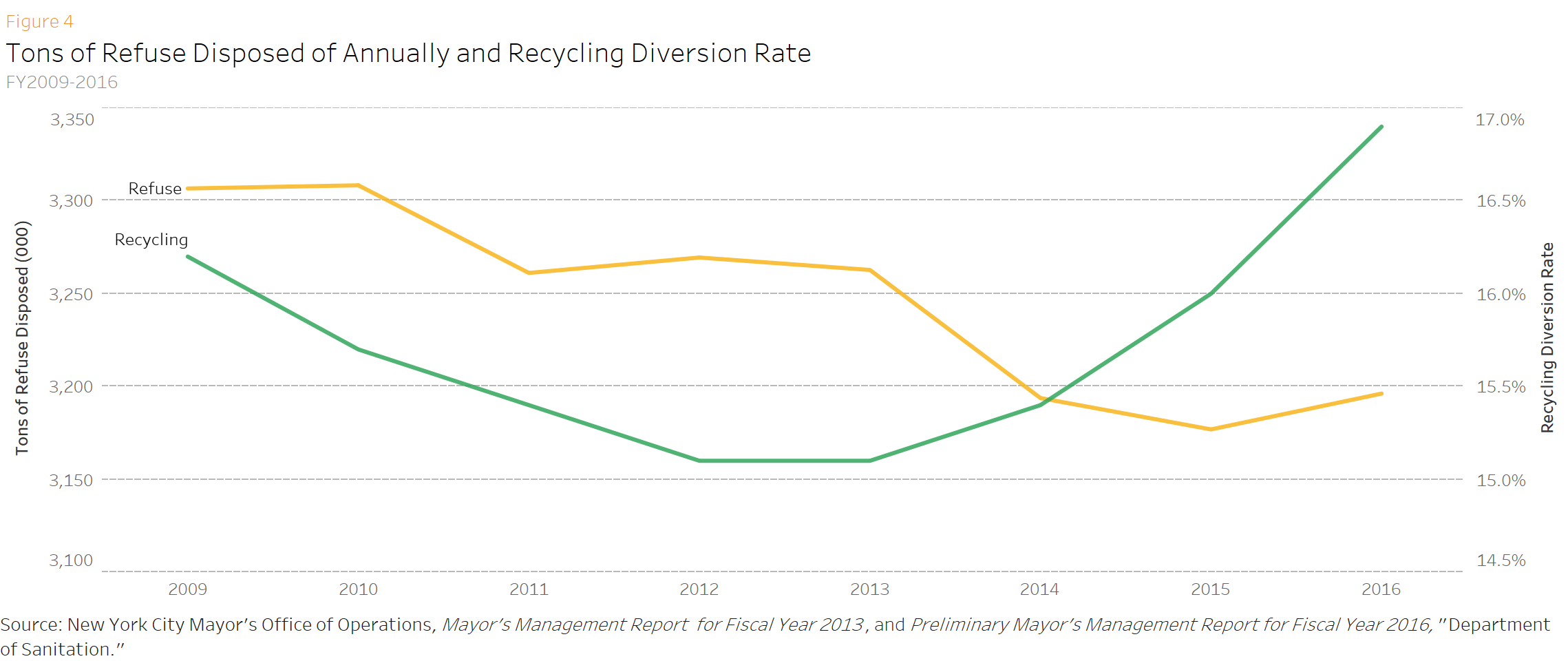
More Ferry Passengers
Ridership on the Staten Island Ferry grew from 2.19 million to 2.31 million, an increase of 5.3 percent from FY15 to FY16. According to Mass Transit, this is a record breaking number of passengers, with roughly 1 million more than there were when the previous record was set in 2012. The mayor attributes the rise in ridership to a strengthening economy and the implementation of ferry service every 30 minutes all day every day that started last fall. Average monthly ridership on the East River ferry increased even more drastically from 113,366 in FY15 to 131,896 in FY16, a 16.3 percent change.
Fewer Traffic Fatalities
The City launched Vision Zero in January 2014, when de Blasio took office, with the goal of cutting New York City traffic fatalities in half by 2025. Two years later, the Mayor’s office announced that 2015 was the safest year ever on New York City streets since the City began keeping records in 1910. In fiscal year 2016, the city moved another step closer to the Vision Zero goal for traffic fatalities, which decreased by 5.2 percent from 249 in FY15 to 236 in FY16. Passengers saw the greatest decrease in fatalities, down 24.2 percent from 33 to 25 this year. Though the same cannot be said for every category, as bicyclists and motor vehicle operators saw an increase in fatalities this past fiscal year (see “Roads are Less Safe for Cyclists and Motor Vehicle Operators” below).
Fewer Unsheltered Homeless as More Supportive Housing is Made Available
The most visible homeless population is those who live unsheltered on the city’s streets, even though they make up a small fraction of the total homeless population in New York City. Compared to the majority of the city’s homeless population, serious mental illnesses are far more common among people who live on the street. With the help of volunteers and nonprofits who work with the homeless population, the City conducts an annual census of people counted as homeless and living unsheltered on the city’s streets each winter. In fiscal 2016, the number of unsheltered homeless persons declined from 3,182 the previous year to 2,794, a 12.2 percent change.
At least part of this decline can be attributed to new units of supportive housing made available to people with serious mental illnesses, which increased 5.3 percent in FY16. Gotham Gazette has written extensively about City and State supportive housing initiatives, which include social services for people with mental illness, substance abuse problems, and other impediments beyond housing insecurity, and are seen as a cost effective solution. The flip side of these services and a result of the ballooning homeless population in general is the mounting cost of services for the city’s homeless people (see “The City is Spending More on the Homeless as Shelter Populations Swell” below).
Tenants Found More Affordable Apartments and Landlords on Notice
Under Housing New York, the City is targeting the affordable housing crisis that plagues many rent burdened residents across the five boroughs -- renters who are spending more than one-third of their income on housing. In FY16, the number of affordable units completed increased dramatically from 2,079 in FY15 to 10,292 -- a 395 percent increase. The Department of Housing Preservation and Development surpassed its goals for starting and completing units in fiscal 2016, increasing its completions by 82 percent and the number of starts by 15 percent compared to the previous fiscal year, according to the Citizens Budget Commission.
Furthermore, the number of applicants placed in housing through federal Section 8 vouchers increased from 892 in FY15 to 1,706 in fiscal 2016. This all comes as fewer landlords are cutting off tenants’ heat and hot water -- a tactic commonly used by landlords to force rent-stabilized tenants out of the building so they can renovate the units and increase the rent market rates. Heat and hot water complaints received by the City decreased 10.3 percent, from 122,612 in fiscal 2015 to 109,950 in fiscal 2016. The city also provided many more lawyers to tenants for housing court eviction proceedings.
Fewer Families Returning to Shelters from Permanent Housing
The homelessness crisis facing New York City has antecedents in the collapse of rental subsidies during the Bloomberg administration. As a result, millions of tax dollars were spent when thousands of New Yorkers were forced back into the shelter system after their subsidies abruptly ran dry. With Section 8 vouchers and other rental subsidies programs back online and growing, fewer families are returning to shelters after living in permanent housing.
The percentage of households and people who returned to the shelters within one year after leaving to live in permanent housing decreased in fiscal 2016 by 6.5 percent for families with children and by 5.5 percent for adult families. Single adults saw minimal change. This comes as more people are in need of emergency grants to prevent eviction. In fiscal 2016, there were 82,306 households who sought out one-time emergency grants to prevent eviction, which is up 26 percent from 65,138 requests in the previous year, according to the New York Post.
911 Response Times Largely Decrease
NYPD’s end-to-end average response time for all crimes in progress decreased by 23 seconds; 20 seconds were shaved off in response to critical crimes in progress, while average response times for serious crimes in progress decreased by 14 seconds. City officials say the decrease in response times are a result of new smartphones and tablets distributed to uniformed officers, according to Politico New York. At the same time NYPD is responding more swiftly to critical and serious crimes, they’ve added over a minute of time in response to non-critical crimes in progress.
Comparatively, the Fire Department maintained or slightly improved its average response time to life-threatening medical emergencies and structural fires as the number of medical emergencies NYFD responded to increased by 8 percent in fiscal 2016, according to the Citizen Budget Commission.
THE NEGATIVE
Rise in Major Felony Crimes
While New York City had a decrease in murder and nonnegligent manslaughter in fiscal 2016, major felony crimes including rape, robbery, and serious assaults increased, especially in public housing developments and the subway system. In FY16 there were 1,742 more major felony crimes committed than in FY15, a 1.7 percent increase, according to the Citizen Budget Commission (see CBC graph below).

The New York Daily News reports a 10 percent increase in major felony crimes committed within the transit system, according to the MMR, while Politico New York found major felony crimes at NYCHA developments increased 7 percent in FY16; from 4,858 the previous fiscal year to 5,205 in fiscal 2016. This comes as the average number of hours it takes to resolve emergency service requests in public housing is on the decline from 15 hours in FY15 to 13 hours in FY16, according to the Citizen Budget Commission.
Jails are Less Safe for Inmates
As the Mayor’s MMR press release highlights decreases in total inmate assaults on correctional staff (down 8.5 percent) and for serious injury to staff resulting from such inmate-on-staff assaults (down 42.9 percent), it fails to mention that Rikers Island and other city correctional facilities are less safe for inmates. As the Citizens Budget Commission points out, the number of incidents of inmate-on-inmate violence increased 26.5 percent to reach 47.8 incidents per month per 1,000 average daily inmates. Compared to the previous fiscal year, FY16 saw a 19.3 percent increase in fights between inmates and a 21.3 percent rise in stabbings and slashing, despite a 4 percent decrease of the daily average inmate population, according to Politico New York.
The City is Spending More on the Homeless as Shelter Populations Swell
All three of New York City’s shelter populations grew in fiscal 2016. According to Citizen Budget Commission, the average number of families with children living in shelters grew 2.3 percent, the adult family population in shelters increased nearly 5 percent and the single adult population in shelters grew 12.3 percent.
This comes as the New York Daily News points out that the average daily cost of housing an adult homeless person in the city’s shelter system increased from $78.80 in fiscal 2015 to $94.57 in fiscal 2016. The cost of families increased from $105.37 per day to $120.22 according to the MMR. Furthermore, the average length of stay in the shelter system increased to 563 days for adult families, 29 more days than the previous year’s average. The average length of stay for single adults increased to 355 days, according to Politico New York, reflecting a need for more supportive housing.
According to the MMR, the increased costs for homeless services were due to a list of improvements to shelter services including “increased security costs; new costs for enhancements, including mental health services and activities in adult shelters; cost of living adjustments for contract providers; utilization of emergency commercial hotels; and the opening of new shelters, which generally have higher rent and fixed costs than do older, established facilities.”
More New Yorkers Die of Drug Overdose
In fiscal 2015, 753 people died from drug overdoses. That number increased to 939 during fiscal 2016, a 24.7 percent increase. Politico New York reports that the increase is connected to more use of opioids like heroin and fentanyl, which is said to be even more potent.
Roads are Less Safe for Cyclists and Motor Vehicle Operators
While the City celebrates another year of decreases in overall traffic fatalities, there were increases in fatalities for cyclists and motor vehicle operators. There were 20 cyclists who died in fiscal 2016, up from 16 deaths in fiscal 2015. Gothamist has written a report looking into this problem. Driver fatalities resulting from traffic accidents increased from 29 in FY15 to 34 in FY16.
Fewer Patients Used NYC Health + Hospital Services
While enrollment in MetroPlus health insurance offered by New York City Health + Hospital increased 6 percent in fiscal 2016 to over 500,000 patients, the number of unique patients that the system served declined for another consecutive year, according to Citizens Budget Commission. There were just over 1.17 million patients served in FY15, while the number fell to under 1.17 million in FY16.
Employment for People with Cash Assistance Not Rising as Fast as the Caseload
Under the Temporary Aid to Needy Families Program (TANF), Eligible families may receive up to 60 months of federally funded cash assistance. Those enrolled in the program must engage in occupational or educational activities to continue receiving funding. The program is suppose to move people from poverty and unemployment and into a full time job. From fiscal 2015 to 2016, the City’s caseload for people who receive cash assistance grew from 360 to 370, a 2.6 percent increase, according to Citizens Budget Commission. During the same period, the number of cash assistance recipients placed in employment stayed the same at 47 people, showing little to no improvement in helping these people land a job.
OTHER POSITIVE INDICATORS
NYC Students Doing Better and Graduating at Higher Rates
The four-year graduation rate in School Year 2015 rose two percentage points to 70.5%; English results on grade 3-8 state tests increased in each of the City’s 32 Community School Districts across all five boroughs; students in grades 3 to 8 meeting/exceeding standards in Math increased 1.2 percentage points (from 35.2% to 36.4%) and meeting/exceeding standards in English increased 7.6 percentage points (from 30.4% to 38%); parents attending parent-teacher conferences increased 3.8% (from 1,910,000 to 1,983,000).
Most Resurfaced Roads in 25 Years
Lane miles resurfaced citywide, in-house plus contracted, was 1,281 – the largest number of lane miles resurfaced citywide in more than 25 years
More CitiBike Trips
CitiBike trips increased 39.6%, from 8.8 million in FY15 to 12.2 million in FY16.
Select Bus Service Ridership Drastically Rises
Annual Select Bus Service ridership increased 27.8%, from 45.2 million in FY15 to 57.8 million in FY16.
More New Yorkers Using Rec Centers
Total recreation center attendance increased 25.0%, from 3.4 million in FY15 to 4.3 million in FY16.
Fewer Reports of Neglect and Abuse for Children in Child Care
Substantiated abuse and/or neglect reports for children in child care decreased 12.5%, from 27.6% in FY15 to 15.1% in FY16.
Fewer Inmate Assaults on Corrections Staff
Serious injury to staff as a result of inmate assault on staff decreased by 42.9%. Total inmate assault on staff decreased by 8.5%.
Fewer Water Main Breaks
Water main breaks decreased 29.8%, from 563 in FY15 to 395 in FY16.
Improved Taxi Services for People with Disabilities
Active medallion taxis that are accessible increased 53.1% (from 572 to 876); Active Boro Taxis that are accessible increased 12.3% (from 1,240 to 1,393).
Cleaner Streets
Streets rated acceptably clean increased 2.3 percentage points, from 92.7% in FY15 to 95.0% in FY16.
More Timely Services for Food Insecure Families
SNAP application timeliness rate increased 12.5 percentage points (from 81.4% to 93.9%); cash assistance application timeliness rate increased 3.1 percentage points (from 94.4% to 97.5%).
Less Wait Time For Information
Wait time for 311 calls decreased 7 seconds, from 23 seconds in FY15 to 16 seconds in FY16
More New Yorkers with City ID
IDNYC cards issued increased 62.5%, from 334,794 in FY15 to 544,083 in FY16.
***
by William Fowler for Gotham Gazette
@GothamGazette

